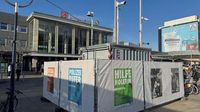The Dortmund Hauptbahnhof is intensifying its security measures following a shocking knife attack that occurred earlier this month. On March 6, 2025, a 22-year-old man stabbed a 56-year-old ticket seller, leaving him with life-threatening injuries after an argument regarding a bus ticket renewal. In response, the Dortmund police have rolled out new video surveillance at the station in an effort to bolster safety and rapidly investigate such incidents.
As of March 21, 2025, video surveillance has been implemented on the forecourt of the station, starting with mobile observation containers. Plans are already underway for the installation of fixed cameras, which will enhance the monitoring capabilities in the busy transportation hub. Police officials emphasize that the video surveillance measures are essential to their strategy against street crime in the area.
According to Dortmund's police president Gregor Lange, “The rapid implementation underscores our determination in the fight against street crime!” The surveillance will be focused on strategically important areas around the station, including Königswall 15, Platz der Deutschen Einheit, Katharinentreppe, and Max-von-der-Grün-Platz, effective from 1 PM to 8 PM on weekdays and from 6 PM to 3 AM on weekends.
This heightened surveillance comes on the heels of a significant crime wave; after a disturbing 2024 saw Dortmund Hauptbahnhof recorded the second-highest violent crime rate in Germany, with 735 reported incidents, only trailing behind Berlin Hauptbahnhof, which registered 764 crimes. This troubling statistic raises persistent concerns over passenger safety in public transport hubs.
But it’s not just video cameras that are being deployed. Dortmund's security strategy also includes increased police presence and focused operations involving both uniformed and plainclothes officers to ensure a more proactive approach. The presence of additional security personnel, trained to handle various situations, aims to deter would-be offenders and reassure the public.
This incident has shocked the community, as ticket seller victim had worked tirelessly serving commuters in what many locals regard as a microcosm of Dortmund’s vibrant culture. Amid intertwining foot traffic, local residents noticed the impact of the stabbing incident, illustrating how deeply this area is intertwined with community life.
Witnesses reported chaos inside the station during and after the attack. The assailant became violent after becoming enraged over the requirement of producing valid identification while renewing a bus ticket, ultimately returning an hour later to carry out the attack. He was apprehended on-site, and has since confessed to the crime.
Local business owners around the station, like Aihan Jamil, view the situation through a lens of concern for safety, saying, “There’s never a day without police taking someone away who has been fighting.” He has also shared how the incident has impacted his livelihood, noting that previously he had staff preparing food alone early in the morning, a practice that has since changed to ensure added safety.
The overarching goal remains focused on re-establishing a sense of security for those who frequently utilize this vital train hub. As authorities work diligently to improve protective measures, perceptions among the public vary significantly. Some feel a greater sense of security thanks to visible police presence, while others remain apprehensive about encountering homeless individuals who sometimes cluster nearby.
The police have also indicated that ongoing assessments of the effectiveness of their surveillance measures and approaches to security will be conducted regularly, ensuring that citizen rights are adequately safeguarded while also addressing crime vulnerabilities. “We need to balance safety with civil liberties, and our approaches to surveillance will be adapted as we receive new information and data,” Lange added.
Interestingly, not all individuals facing criminal charges view these encounters with the same concern as they are halted or questioned about improper behavior or the presence of weapons. According to a police officer, “Given the nature of this station, we are allowed to perform checks without necessarily having a specific cause. This is important, as these areas can be prone to crime and safety risks.”
Some passengers have expressed an unsettling awareness of their surroundings as they navigate through the bustling complexities of travel, giving rise to anticipatory discomfort regarding encounters with strangers and potential risky situations. “I would be very hesitant to catch a late train here at night,” commented frequent traveler Peter Leisner, illuminating fears that echo throughout the community.
It’s clear that the Dortmund Hauptbahnhof stands at a crossroads between revitalizing its reputation as a safe travel hub and confronting the deeper social issues surrounding crime in urban environments. On one weekend rather recently, officials had to cordon off the station after a suspicious backpack was discovered near the premises, illustrating the continuing tension that pervades everyday life at public transportation sites.
The city is now on a mission to address these multifaceted societal elements connected with traveling safely. Local authorities are placing an emphasis on collaboration with various stakeholders, encouraging effective measures to bolster the sense of security for all travelers.
While the surveillance effort is being met with understanding from some quarters, there are clear divides in perspective on how to effectively manage homelessness and crime at Dortmund Hauptbahnhof, ensuring travelers and residents are safe moving forward.
This heightened focus on safety and vigilance will indeed continue to unfold as the community seeks ways to recuperate from recent traumatic experiences while ensuring that the public transportation system both operates efficiently and fosters a welcoming atmosphere.





